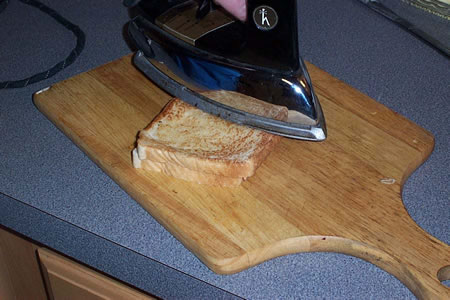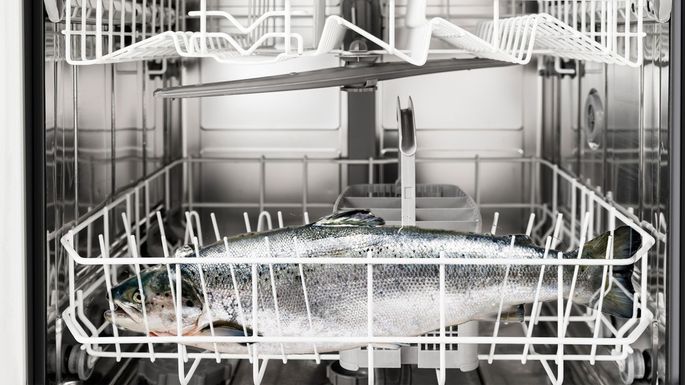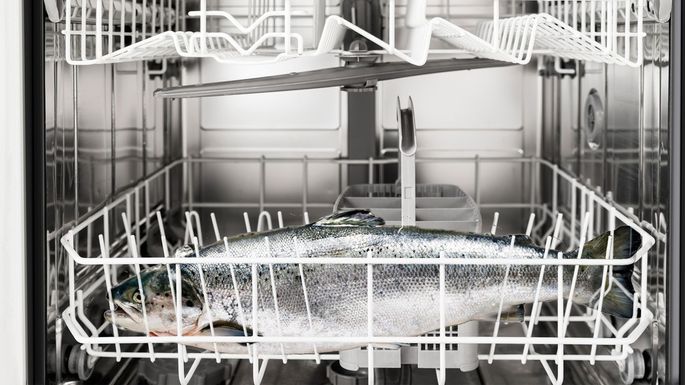In March, I wrote about a tenant of mine who complained about a bad smell in her dishwasher, and when I went over to her apartment to investigate, I discovered that she had been cooking fish in her dishwasher. I later found out that she was also making grilled cheese sandwiches with a clothes iron. I asked her if her stove was working OK, and she said it was, but she said she didn’t like to cook food on the stove. She preferred to cook food with household appliances, but I never found out why. So – maybe it is time that I listed some of the things that people put in their dishwashers but shouldn’t.
Food. Don’t cook
food in your dishwasher. There are a lot of recipes online for food you
can cook in a dishwasher, but you can get sick eating food that you
cooked in a dishwasher. The temperature inside a dishwasher may not get
hot enough to kill microorganisms like salmonella. Use your stove to
cook food.
Sharp knives. Always hand wash sharp knives, cheese
graters, slicers, and anything else that has an edge to it. They can
become dull or nicked in your dishwasher.
Wooden items. Wood
salad bowls, cutting boards, and utensils with wooden handles should be
hand washed. The wood can crack and warp in a dishwasher.
Cast-iron cookware. Washing
cast-iron cookware in a dishwasher strips off the baked-on oil and
seasoning that gives cast-iron cookware a slick surface and prevents
rusting and food from sticking.
Computer keyboards. Yes, it is
hard to clean a computer keyboard, but if you put in your dishwasher,
water will get inside the keyboard and probably ruin it.
Footwear.
It may seem like the easiest way to clean waterproof footwear like
Crocs and flip-flops is by putting them in the dishwasher, but the heat
in your dishwasher can warp and shrink footwear and make it brittle.
Delicate clothing. Some
clothing items, like wool sweaters, silk scarves, and bras say on them
that you shouldn’t put them in a washing machine or clothes dryer. That
doesn’t mean that is safe to put them in a dishwasher instead.
Insulated
mugs. Water and heat can damage the vacuum seal between the inside and
outside layers of the mug. Once the vacuum seal is broken and water gets
inside, the mug will permanently lose its ability to retain heat or
cold.
Dishwashing liquid. Never put dishwashing liquid in a
dishwasher! Only use dishwasher detergent. Dishwashing liquid is
designed to make lots of bubbles. Dishwasher detergent is not. If you
put dishwashing liquid in your dishwasher, your kitchen could be flooded
with bubbles. Even if that doesn’t happen, your dishes will likely be
left covered with a sticky soapy film.
Non-stick pans. Washing non-stick cookware in your dishwasher will shorten the life of the non-stick coating.
Electric appliances. (This is the most dangerous!)
A lot of people put small electric appliances in their dishwashers,
things like coffee makers, blenders, hair dryers, and popcorn makers.
You should never use an electric appliance that has been in a
dishwasher. Toss it out! Put it in your garbage can before you get
electrocuted!

What was the strangest thing that a tenant of mine put in his dishwasher? Well, I once had a tenant who put an expensive North Face tent in his dishwasher. The heat from the dishwasher shrank the fabric so much that it would no longer fit on the tent poles. He also put his hiking boots in the dishwasher. They were also ruined. He expected me to buy him a new tent and hiking boots. Predictably, he blamed the dishwasher. I refused to pay him, which surprised him, but not his roommates.




